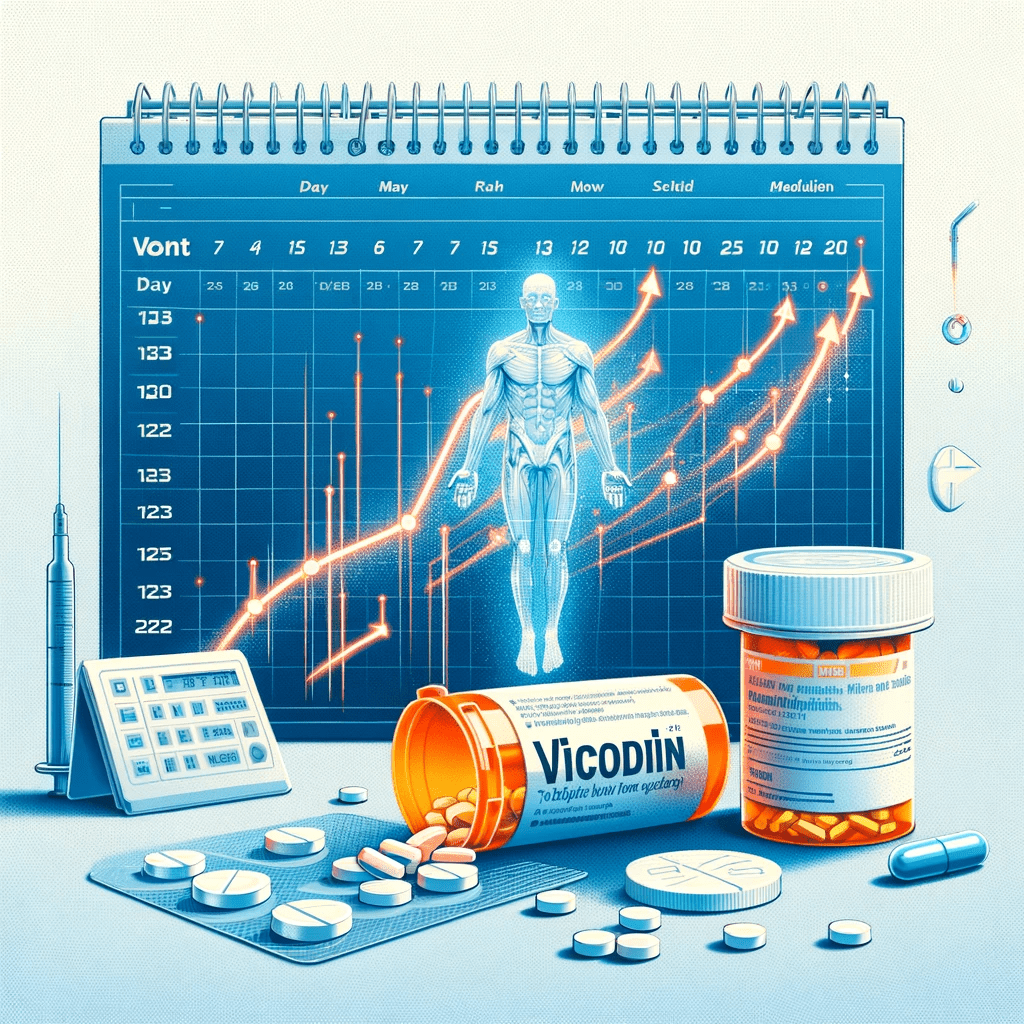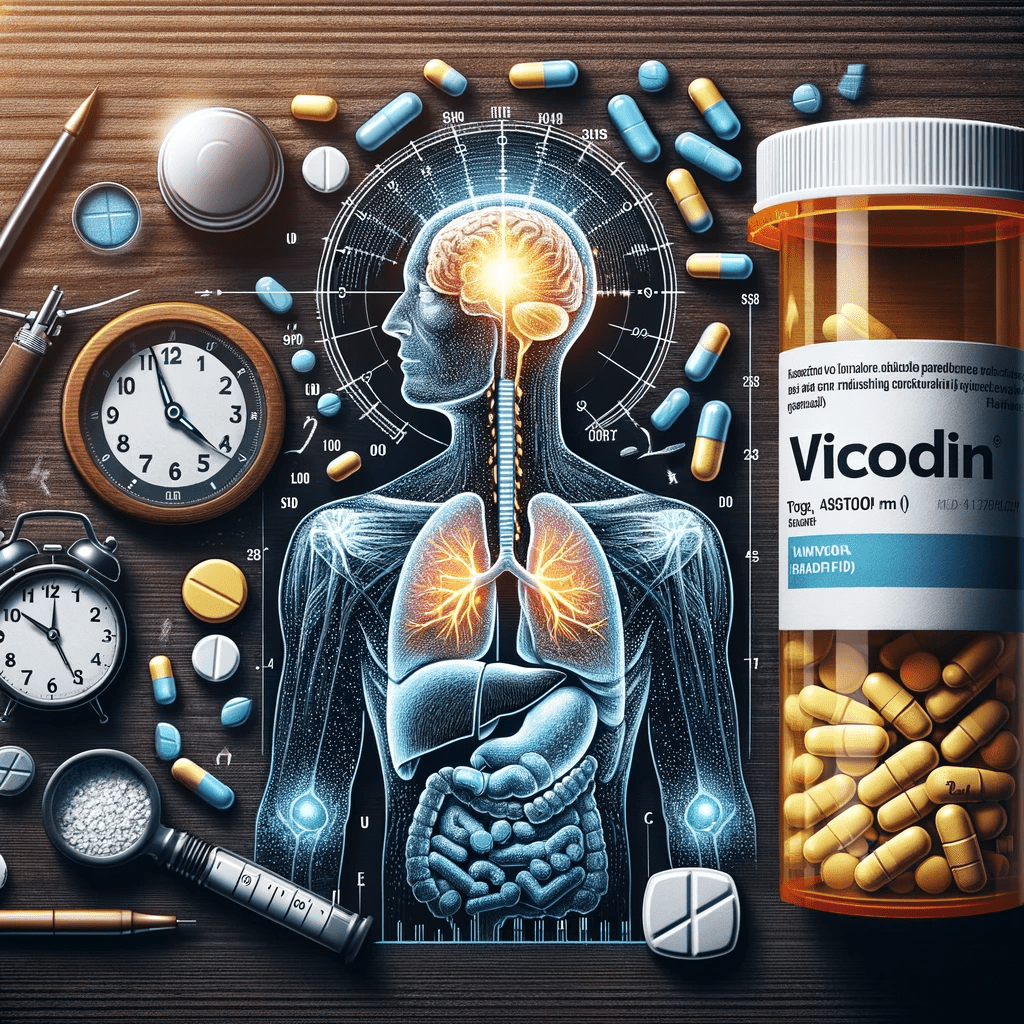How Long Does Vicodin Take to Leave Your System?

- Vicodin is a powerful drug that treats otherwise unmanageable pain for which non-opioid painkillers are insufficient.
- Vicodin contains both hydrocodone and acetaminophen.
- The different active ingredients in extended-release Vicodin can take up to 2 days to leave your body.
- The side effects of Vicodin use range from common ones like temporary lightheadedness to serious ones like respiratory depression and permanent hearing loss.
- If you are addicted to Vicodin, seek treatment immediately.
Vicodin Drug Facts
Vicodin is a powerful Schedule II combination drug containing the opioid hydrocodone and the analgesic acetaminophen.
Vicodin was introduced to the US in 1978 by Knoll, the same German company responsible for synthesizing hydrocodone half a century earlier. In 2011, the average dose of acetaminophen in Vicodin tablets was decreased from 500mg to 325mg due to FDA regulations following research documenting the serious side effects of acetaminophen overdose.[1]
Partially because so many people are unaware of what’s inside combination drugs, acetaminophen toxicity is the most common cause of liver transplantation in the US.[2]
Hydrocodone Drug Facts
Hydrocodone is a semisynthetic opioid invented in 1920 by Knoll, a German pharmaceutical company.
It’s currently used as a pain reliever if non-opioid treatment has proven insufficient and as a cough suppressant in late-stage cancer patients. Due to its high potential for abuse, it can only be legally possessed with a prescription.
It comes in both IR (Immediate Release) and ER (Extended Release) tablets, capsules, as well as oral solutions. The effects of hydrocodone are generally felt within an hour of administration.[3]
Hydrocodone is 1.5x stronger than morphine and is eliminated from the body via the kidneys.[4]
Acetaminophen Drug Facts
Acetaminophen is an analgesic and antipyretic invented in 1893 (initially called “paracetamol”) and then gained widespread popularity as an active ingredient in Tylenol, which was invented in 1955 by McNeil Laboratories.[5]
To avoid confusing it with aspirin meant for adults, they marketed Tylenol as a fire truck to feverish children they labeled “little hotheads.” It’s currently used as a painkiller and fever-reducer for adults and children.
Unlike aspirin, it does not have anti-inflammatory effects. While acetaminophen may reduce the pain associated with fever, it won’t reduce the inflammation itself.
Acetaminophen is responsible for 56,000 emergency room visits, 2,600 committed hospitalizations, and 500 deaths annually in the United States.[6]
50% of these deaths, or around 250, are unintentional overdoses. While over 60,000,000 Americans consume acetaminophen per week, many are unaware it is contained in combined drug products like Vicodin.
Vicodin Initial Dosage (Tablets)
| Dose (Hydrocodone/ Acetaminophen) [7] | Frequency interval | Number of doses recommended during interval |
Number of doses not to exceed per day |
|
2.5 to 5mg/325mg |
4 to 6 hours | 1 to 2 | 8 |
| 7.5 to 10mg/325mg | 4 to 6 hours | 1 |
6 |
Vicodin Mechanism of Action
Vicodin has two active ingredients: Hydrocodone and Acetaminophen
Hydrocodone’s Mechanism of Action
Hydrocodone attaches to mu-opioid receptors at low doses and additionally at delta and kappa receptors at higher doses.[8]
Mu-opioid receptors are responsible for signaling the brain to release dopamine, which is a feel-good hormone. Dopamine is part of our brain’s reward system to encourage us to partake in healthy activities like eating, drinking, working out, and having sex.
Because it is semi-synthetic, hydrocodone can produce a more powerful subjective experience of pleasure than everyday healthy activities through natural dopamine responses. This experience of intense pleasure has analgesic properties.[9]
For chronic coughing, hydrocodone directly affects the “cough center” of the brain’s medulla by causing respiratory depression.[10]
Acetaminophen’s Mechanism of Action
Though it’s been studied for over 130 years, the exact mechanism of action for acetaminophen continues to baffle researchers.[11]
In the 1970s and 2000s, researchers thought they had determined why acetaminophen worked, but their hypotheses did not hold up to further scrutiny.
The current prevailing theory is that acetaminophen inhibits CNS cyclooxygenase (COX) enzyme activities.[12] After all, this is why NSAIDs are believed to work. However, the binding of acetaminophen to COX receptors is shown to be too weak to be responsible for pain relief.
COX is believed to affect our thermoregulatory centers, pushing our core body temperatures above 98.6°. This could explain why acetaminophen has antipyretic qualities if it indeed blocks COX enzymes.
The exact mechanism of action is, currently, still speculation. Because overdosing on acetaminophen is associated with liver damage, it is important that the mechanism of action eventually be determined.[13]
Metabolism and Metabolites
When substances enter the body, they undergo metabolism, which is the process of chemical transformation, often resulting in their breakdown and conversion into forms that can be utilized for energy or more easily excreted from the body.
Hydrocodone has several metabolites, with the primary metabolite being hydromorphone.[14] Pain relief is associated with hydromorphone plasma concentration.
Acetaminophen also has several metabolites, with the primary metabolite being glucuronide.[15] A small percentage of acetaminophen is oxidized into the reactive metabolite NAPQI, which is responsible for liver damage.
Both are absorbed via the liver and excreted via the kidneys.
How Long Does Vicodin Stay In Your System?
While you’ll likely experience the analgesic effects of Vicodin within an hour, the combination of drugs inside it in the extended-release formulation could take up to two days to leave your system.
How Long Does Vicodin Take to Kick In?
The subjective experience of analgesia is achieved when peak plasma concentrations have been reached for the metabolites of hydrocodone and acetaminophen.
The immediate-release (IR) version of hydrocodone will reach peak plasma concentration in about 1 hour, while the extended-release (ER) version will reach it in approximately 14 to 16 hours (range of 6 to 30 hours). Hydrocodone’s oral bioavailability is approximately 50%.[16][17]
Acetaminophen will reach peak plasma concentration in about 30 minutes to 2 hours.[18] It has a high oral bioavailability of 88%.[19]
What Is The Half-Life of Vicodin?
Since Vicodin is a combination drug, there is no single number available for the half-life. There are two separate numbers since hydrocodone and acetaminophen have different half-lives.
An elimination half-life is the time it takes for only 50% of a given substance to be eliminated from the body. It takes 4 to 5 elimination half-lives to statistically eliminate a substance entirely from the body.
Hydrocodone Half-Life
The documented elimination half-life of immediate-release (IR) hydrocodone is 4 hours, while the elimination half-life for extended-release hydrocodone is 7 to 9 hours.[20] This means IR hydrocodone can be statistically eliminated from the body in the range of 16 to 20 hours, while ER hydrocodone can be statistically eliminated from the body in the range of 28 to 45 hours.
Acetaminophen Half-Life
The elimination half-life of acetaminophen is 2 hours, but in the case of overdose, it’s 4 to 8 hours.[21] The extended half-life is directly related to the extent of liver damage by acetaminophen metabolite NAPQI. Acetaminophen can be statistically eliminated from the body in 8 to 10 hours under non-toxic circumstances and anywhere from 16 to 40 hours following an overdose.
Effects of Long-Term Vicodin Use
Long-term Vicodin use can increase the likelihood of both addiction and overdose, even if taken as prescribed. Discuss any plans for taking Vicodin with your doctor.
Common Side Effects of Vicodin
The most frequently reported side effects of Vicodin are lightheadedness, dizziness, sedation, nausea, and vomiting.[22] These are generally mild and retreat upon stopping medication.
Serious Side Effects of Vicodin
More serious side effects of Vicodin include respiratory depression, which, when severe, can contribute to respiratory acidosis.[23] Some symptoms of Vicodin toxicity include:
- Drowsiness, brain fog, low energy, acute or generalized anxiety, fear, psychological dependence, and/or mood changes
- Constipation
- Urine retained in the bladder
- Slowed breathing rate
- Hearing loss
- Itching or rash
Treatment For Vicodin Addiction
If you are addicted to Vicodin, seek treatment immediately.
Do not hesitate. Seize the moment and find a treatment center with staff specializing in chemical dependencies. Substance use disorders are difficult to manage, and for the best chance of long-term sobriety, you need a compassionate treatment team who will get behind you to offer you every chance of success.
We operate two facilities: an addiction rehab center in Tennessee and a premier quality drug and alcohol treatment facility in New Jersey. Both centers are dedicated to providing top-notch rehab services. Whether you’re battling addiction or facing mental health challenges, our Nashville mental health hub is here to offer support. We strongly believe in transformation through recovery and offer a variety of tailored programs and therapies meticulously crafted to address each client’s individual needs. If you need help or have questions, contact us.
Frequently Asked Questions About Vicodin

